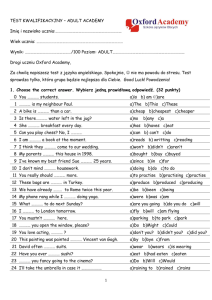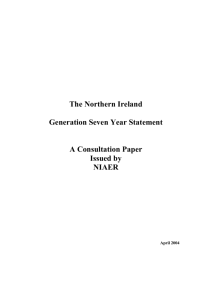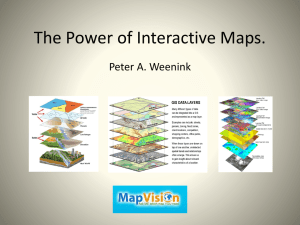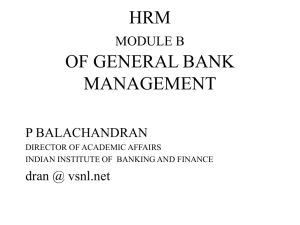AMB005 Introduction to instructional technology
advertisement
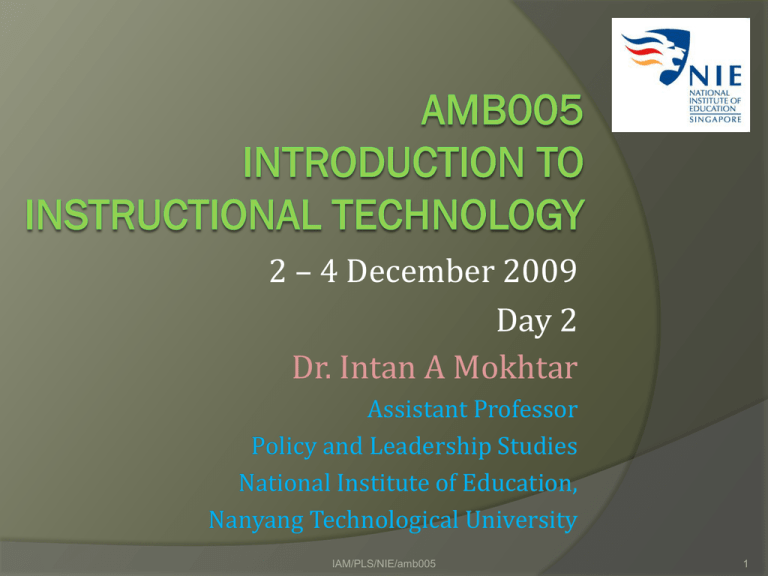
2 – 4 December 2009 Day 2 Dr. Intan A Mokhtar Assistant Professor Policy and Leadership Studies National Institute of Education, Nanyang Technological University IAM/PLS/NIE/amb005 1 2. Instructional Technology Tools (Continuation) Day 2 IAM/PLS/NIE/amb005 2 Searching the Web Robotic search engines Use algorithms or software known as spiders to crawl the Web through hyperlinks, looking for popular or relevant webpages Two kinds: Regular search engines eg. Google, Live Search Meta-search engines eg. Dogpile, Mamma Day 2 Searching of documents and websites on the Web through the use of keywords or search strings IAM/PLS/NIE/amb005 3 Searching the Web Subject directories Such as Yahoo, Dmoz Open Directory Shows a list of general subjects eg. News, Science, Health, Arts, Business, etc. Each category is sub-divided into sub categories eg. Health > fitness, medicine, alternative medicine, etc. Useful for subject- or discipline-oriented search Categories and websites are selected by human indexers Day 2 IAM/PLS/NIE/amb005 4 Searching the Web Online databases Collection of documents or bibliographic information related to specific disciplines Documents full-text database Bibliographic information index Requires network connection Hyperlinking and cross-referencing may be possible Examples are MedlinePlus, IMDB, DOAJ Day 2 IAM/PLS/NIE/amb005 5 TEA BREAK Day 2 IAM/PLS/NIE/amb005 6 3. Issues Day 2 IAM/PLS/NIE/amb005 7 Evaluation of IT resources Interoperability & Transferability Knowledge & Skills Budget Issues Accessibility & Equity Day 2 Security & Privacy IAM/PLS/NIE/amb005 8 Evaluation of IT resources Accessibility & Equity Day 2 Not all IT resources are available to all students e.g. students with computer + Internet connection vs. students with only a computer Some IT resources are freely available while others require subscription or affiliation-based access Some IT resources are accessible only by those who have specific faculties intact e.g. multimedia video presentation (requires sight + hearing) vs. a textbook (requires sight only) IAM/PLS/NIE/amb005 9 Evaluation of IT resources Accessibility & Equity Day 2 Different IT resources can provide different quality of information e.g. comparing historical information delivered through an audio recording vs. the same information delivered through a multimedia video presentation IAM/PLS/NIE/amb005 10 Evaluation of IT resources Budget How much money will it involve to procure certain IT resources? Are funds available? If not, what alternatives are there? No. of licenses available can each trainee have access? Day 2 IAM/PLS/NIE/amb005 11 Evaluation of IT resources Interoperability & Transferability Upgrade from existing set of IT resources Can older versions be used with the new ones? Can the new versions be used on different platforms? e.g. Apple iWork (Pages + Keynote + Numbers) in an MS Office Suite (Word + Powerpoint + Excel) Day 2 IAM/PLS/NIE/amb005 12 Evaluation of IT resources Knowledge & Skills What sort of prior knowledge or skills are required? E.g. some prior programming language? How much new knowledge or skills are required? E.g. learn a new programming language? Will the new knowledge or skills be easy to obtained? How much time will be required? Day 2 IAM/PLS/NIE/amb005 13 Evaluation of IT resources Security & Privacy Can the IT resources be used remotely? Or would a network connection always be required? If the IT resources are downloaded, are there cookies involved? Will privacy be invaded? How secure is it to use the IT resource? Risks of viruses or spyware? Day 2 IAM/PLS/NIE/amb005 14 Evaluation of IT-based information 5Ws + 1H of IT-based information (Adapted from Schrock, 2009) WHO Who wrote the information and are they experts? Is a biography of the author(s) included? How can I find out more about the author(s)? WHAT What does the author say is the purpose of the information? What else might the author have in mind for the information? What makes the information easy to use? Day 2 IAM/PLS/NIE/amb005 15 Evaluation of IT-based information 5Ws + 1H of IT-based information (Adapted from Schrock, 2009) WHEN When was the information created? When was the information last updated? WHERE Where does the information come from? Where can I go to find out more about the information (i.e. references, related readings)? Day 2 IAM/PLS/NIE/amb005 16 Evaluation of IT-based information 5Ws + 1H of IT-based information (Adapted from Schrock, 2009) WHY Why is this information useful for my purpose? Why should I use this information? Why is this page better than another? HOW How does this information differ from another that is similar? Day 2 IAM/PLS/NIE/amb005 17 Evaluation of IT-based information Search Activity Find information on a specific topic of your choice using: (i) A robotic search engine (ii) A subject directory (iii) An online database Determine the following: a. How many ‘clicks’ you need to make before getting to the information required b. If the information requires subscription c. When the information was last updated d. Who put together/produced the information Day 2 IAM/PLS/NIE/amb005 18 LUNCH Day 2 IAM/PLS/NIE/amb005 19 4. Assessment Day 2 IAM/PLS/NIE/amb005 20 Assessment Assessment is carried out to determine learning effectiveness and gauge performance or achievement In other words, assessment is done on the process and product Formative assessment measures the process how methods/learning can be improved; strengths and weaknesses Summative assessment measures the product how well has something been achieved; ranking system with parameters Day 2 IAM/PLS/NIE/amb005 21 Assessment BOTH formative and summative assessment should be carried out to give a complete picture of the effectiveness + performance Qualitative and quantitative methods can be done for both formative and summative assessment Qualitative : descriptive, more subjective Quantitative: numerical, set parameters Day 2 IAM/PLS/NIE/amb005 22 Assessment Qualitative Blogs – reflection of experiences, learning process, identification of strengths and weaknesses Discussion forums – sharing of ideas, critique of one another’s ideas Wikis – collection of information that has been built collaboratively (improvement of one another’s contributions) Day 2 IAM/PLS/NIE/amb005 23 Blogs, Reflective journals and Discussion forums Day 2 Blogs Blogger, Live Journal, Word Press, etc. Discussion boards or forums allow you to be the administrator (control content and membership) Freeboards – free web hosting, decide on URL name, link from own website, requires registration Yahoo Group– free, on Yahoo site only, requires registration, security may be questioned phpBB – free open source software, downloadable and to be hosted on your own server IAM/PLS/NIE/amb005 24 Blogs, Reflective journals and Discussion forums Wikis allow you to create a sharing space BUT you can also control if it is for content contribution or reading only Wikispaces – free and paid plans available, WYSIWYG editing, 2GB file storage on server, requires registration Wikisite – free, WYSIWYG editing, requires registration, 3 hosting solutions (personal, group or advanced) Common wikis include Wikipedia Wikimapia Day 2 IAM/PLS/NIE/amb005 NUS Wiki 25 TEA BREAK Day 2 IAM/PLS/NIE/amb005 26 Assessment Quantitative Online tests and quizzes – to assess content knowledge and understanding; to compare across students Some are created directly and stored on a central server Some require software to be downloaded onto your own computer and thereafter uploaded onto a central server Day 2 IAM/PLS/NIE/amb005 27 Hot Potatoes, Easy Test Maker and Quiz Center Day 2 Hot Potatoes – freeware, requires software to be downloaded onto your computer. Completed quizzes can be uploaded onto the Web. Easy Test Maker – free but registration required (including email and postal address). Immediate use of default package upon registration. Extra features available with subscription. Quiz Center – free but registration required (including email address only). Much easier access. Class Marker IAM/PLS/NIE/amb005 28 Exam Builder, Clickers Day 2 Exam Builder – used by Fortune 500 companies, timed examinations; statistics provided; 30-day free evaluation account; after that subscription required; hosted and managed solution Clickers – remote personal response system; NOT for free, purchase required; use radio or infra-red frequency for each clicker to communicate with the receiving station on the instructor’s computer; provide immediate feedback to MCQs or T-F questions IAM/PLS/NIE/amb005 29 End of Day 2 Day 2 IAM/PLS/NIE/amb005 30
